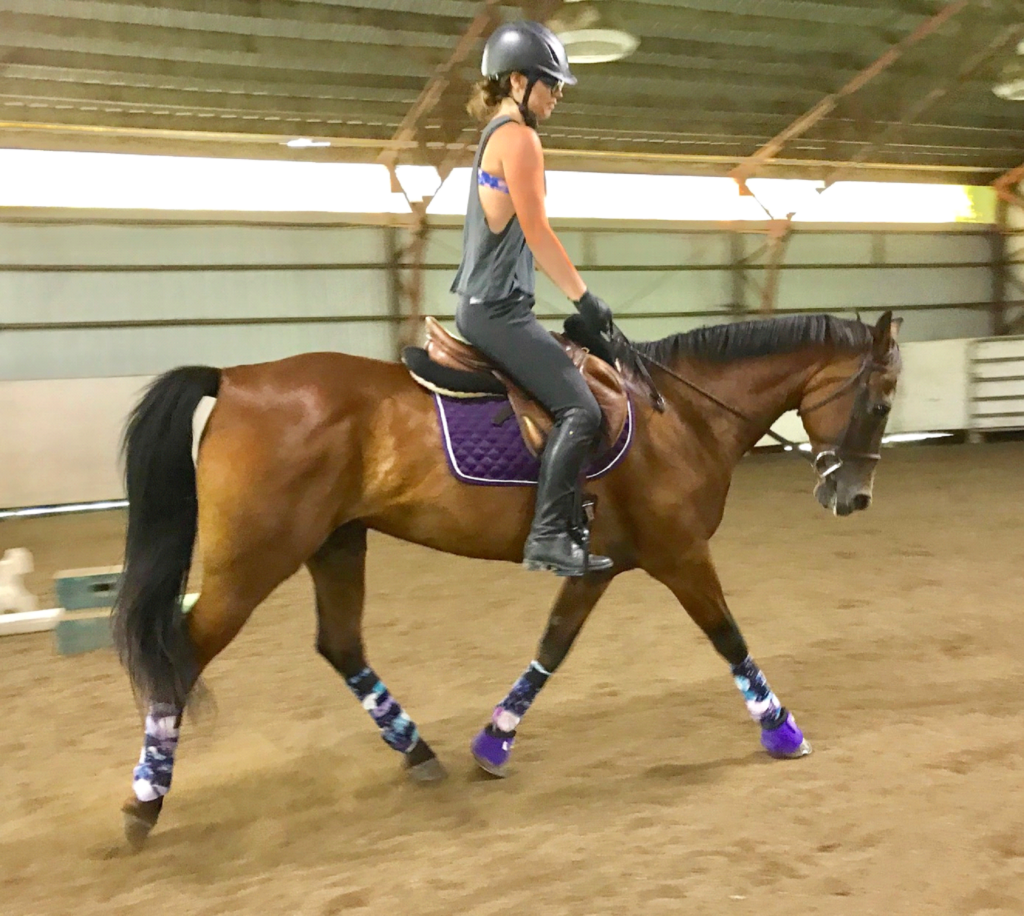By Kristin Hermann
If your horse is moving forward, that is an indication of the horse using his back or whole top line. You can tell if the horse is using its back or moving forward if the horse is tracking up. Tracking up, or covering ground, means the horse is taking a full stride and using its back.
Often when I am judging or training, I say that the horse that needs to cover more ground because it is not tracking up. I don’t like to use the word “forward” because riders misunderstand and often allow the horse to rush or get quick which is moving forward in a bad way. But how does a rider know the difference between rushing which is bad and a horse moving nicely forward?
Tracking up (or a ground covering stride) is what we want as riders in order to know the horse is using its back. We want the horse to use its back in order to lift the rider’s seat and not concave under the weight of the rider. In order for the horse to effectively carry the rider and keep the back lifted, its stride needs to be long or using its full range of motion. Certainly, we don’t want our horse to have an upside down back and a choppy short stride.
As “dressage” riders, we hear all the time that our horses should be more forward, but the word isn’t even on the USDF Training Scale. The training scale consists of Rhythm, Relaxation, Contact, Straightness, Impulsion and then Collection. At my school of training at Coventry Equestrian Center, we focus on relaxation and rhythm and then contact just like the USDF training scale suggests. Once the horse has these basics in both directions, we then practice keeping these qualities on straight lines and then splice in impulsion when the time is right.
If a horse is not going forward enough, then it is apparently not using its back. We need to ask for more forward and ground covering stride, but rhythm and relaxation should never be compromised. If the rider puts “forward” at the beginning of the training scale without prioritizing relaxation or rhythm, then they will likely get rushing, and the horse will appear to be out of balance and too quick.
America is the melting pot of riders from around the world, and all the different philosophies of training horses can become confusing. When you take a dressage lesson, you should know about the trainers’ background. For instance, does the trainer come from a German background where most of the training was done on horses that pulled cannons (Hanoverians)? Or is your trainer from the French tradition where most of the horses were mostly Thoroughbreds? Or, is your trainer of the Spanish tradition where the horses are mostly Baroque? Each one of these riding styles has a different approach to training because of the breed of horse they were trained on. The German horses that were heavier (except for the lighter Trakehner type that the Germans used for the pony express) needed to go forward. The French thoroughbreds that are already forward needed to work on patience and waiting because they already were forward. The Baroque style horse was typically trained to collect because these types of horses are built for collection and not so much for forward.
The United States Dressage Federation (USDF) has adopted the German method of training, and of course, we all want our horses forward, ground covering and tracking up from behind no matter what breed. We should only ride with trainers that understand each horse needs to be trained differently, not just shouting commands that they heard from someone else. An educated trainer will know when a horse needs to go “forward” or needs to wait, however, all horses need to move with relaxation and rhythm to progress with the training.
Forward does not mean rushing around which typically makes the horse too quick and on the forehand. Out of balanced horses that are rushing forward are not relaxed, and the rider barley has control. No fun! A rider can always ask for more length of stride as long as the three basics of the USDF Training Scale, rhythm, relaxation and contact are not compromised.



